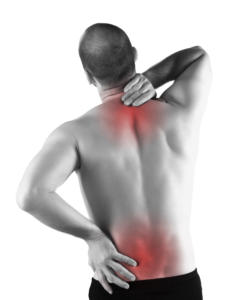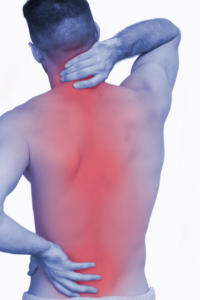Back Pain
Back pain is a very common complaint. According to the Mayo Clinic, approximately 80% of all Americans will have low back pain at least once in their lives.
Back pain is a common reason for absence from work and doctor visits. Although back pain may be painful and uncomfortable, it is not usually serious.
Even though back pain can affect people of any age, it is significantly more common among adults aged between 35 and 55 years. Experts say that back pain is associated with the way our bones, muscles and ligaments in our backs work together.


Back Pain Causes
Pain in the lower back may be linked to the bony lumbar spine, discs between the vertebrae, ligaments around the spine and discs, spinal cord and nerves, lower back muscles, abdomen and pelvic internal organs, and the skin around the lumbar area.
Pain in the upper back may be due to disorders of the aorta, tumors in the chest, and spine inflammation
Back Pain Symptoms
The main symptom of back pain is, as the name suggests, an ache or pain anywhere on the back, and sometimes all the way down to the buttocks and legs. In most cases signs and symptoms clear up on their own within a short period.
Structure of the back
The human back is composed of a complex structure of muscles, ligaments, tendons, disks and bones – the segments of our spine are cushioned with cartilage-like pads. Problems with any of these components can lead to back pain. In some cases of back pain, its cause is never found.
Causes of back pain:
- Lifting something in an improper manner
- Strained muscles
- Strained ligaments
- Lifting something improperly
- Lifting something that is too heavy
- The result of an abrupt and awkward movement
- A muscle spasm.
When to RICE
For approximately the first 72 hours following an injury, the RICE regime should be followed to ensure control of inflammation and pain relief. https://kelleystherapeuticgarments.com/strained-injured-muscles/
R – Rest
I – Ice
C – Compression
E – Elevation
Rest from aggravating activity.
Apply ice in the first 72 hours or when inflammation persists, ice for 15 to 20 minutes at a time. Do not apply ice directly to the skin, but through a wet towel or cloth.
Use an elastic bandage to achieve compression.
http://www.medicalnewstoday.com/articles/172943.php
If the injury is acutely painful or inflamed then applying ice may help reduce muscle spasm. More chronic or longer term conditions may respond better to heat therapy to relax the muscle however, heat should not be applied if an acute injury, inflammation or recent tear of the muscle is suspected as it will only increase swelling, inflammation and bleeding.
For gradual onset or more chronic conditions, heat in the form of a hot bath or hot water bottle applied for approximately 20 minutes three times a day can help to release the muscle spasm and encourage blood flow through the muscle. Applying heat before performing exercises, particularly stretching exercises may help increase the effectiveness of the exercises.
Rest from any activities which make symptoms worse. This is likely to include running and other weight bearing activities.
Self-Care Techniques for Back Pain
Before you pursue a medical evaluation, you may want try the following techniques at home: Take over-the-counter pain medications, and use a hot pack or a cold pack. Or alternate heat and ice on the area, 15 to 20 minutes at a time, several times a day. Try gentle daily stretches for your legs, hips and back. To relieve pressure, use a cushion when you’re sitting.
If you choose the self-care method Kelley’s Therapeutic Garments has a back wrap you will love, click here for more information and to purchase.
If after two weeks there’s no improvement, or if new symptoms develop, see your doctor.

